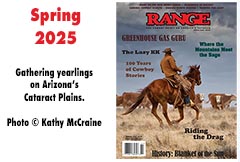|
DESERT
OR
DIVERSITY?
Itâs
time to stop
seeing what
we believe
and start
believing
what we see.
By
Allan Savory
This
is a global
warning. We
can turn our
lands in
seasonally
dry climates
into
lifeless
deserts, or
we can keep
them alive
and vibrant,
conserving
and
nurturing
every drop
of water.
Land on the
threshold of
desertification
can become a
shining
example of
biodiversity.
It doesnât
take any
fancy tools
or expensive
equipment.
All it
really takes
is for
ranchers and
environmentalists
to stop
seeing each
other as
enemies and
look
critically
and
dispassionately
at examples
from around
the world.
Itâs time
to stop
seeing what
we believe
and start
believing
what we see.
In my
homeland of
Zimbabwe,
there is a
worse land
degradation,
poverty and
loss of
wildlife
situation
than in the
arid West of
the United
States. That
can be
changed. It
has already
been
dramatically
changed in
one area
known as the
Dimbangombe
Ranch.
My
wife and I
donated the
ranch to the
people of
Africa to
allow them
to benefit
from
Holistic
Management
practices.
The ranch is
owned by a
local
nonprofit
organization
alongside a
community of
over 145,000
people
living on
communally
owned land
totaling
over a
million
acres.
Dimbangombe
staff work
under a
board of
trustees
that
includes all
five of the
local tribal
chiefs and I
am the
chairman.
The
ranch and
the adjacent
communal
land have
the same
soils and
rainfall.
The communal
land was
settled
because it
held greater
potential
for
agriculture.
Everything
depends on
the rains
that fall
from
November to
March. After
March, the
area gets
increasingly
hotter and
drier until
the rains
come again.
The average
rainfall is
about 30
inches, but
the last two
years have
been below
that.
When
we began
using
Holistic
Management
on the
ranch, its
land was in
a seriously
degraded
state as
photos
illustrate,
although not
quite as bad
as the
communal
lands. Over
the last
seven years,
the contrast
between the
two areas
has grown
increasingly
marked.
The
pictures
here were
taken on a
single day
in March
2004, on
both the
ranch and
communal
lands. They
show the
land at the
best it will
be all year.
After this
point, the
long, hot
dry season
will set in
and things
become
progressively
worse till
the next
rains.
At
the outset,
when we
donated the
ranch land,
it had no
elephant and
buffalo at
all (due to
a veterinary
fence, since
removed),
and a
sparse,
fluctuating
population
of other
game. While
the communal
land still
supports
little
wildlife,
the
situation on
the ranch is
very
different
today. The
ranch now
supports
significant
and
increasing
numbers of
elephants,
buffalo,
kudu, sable
antelope,
waterbuck,
zebra,
impala,
giraffe,
reedbuck and
many other
diurnal and
nocturnal
animals.
Widely
ranging
elephants
can on some
days number
300 or more
and,
likewise,
buffalo
herds from
500 to
1,000.
Clearly
there is a
lesson in
Africa for
us in the
West. Some
will say
what works
in Africa
does not
necessarily
work here.
But as I
have pointed
out for
years, the
ecological
principles I
am
suggesting
we use are
universal. A
number of
ranchers in
the United
States as
well as many
in Australia
have adopted
Holistic
Management
and its
associated
planned
grazing.
They have
shown this
principle of
using
grazing as a
tool to
reclaim and
revitalize
the land to
be correct
wherever
properly
used.
Without
adequate
animal
numbers and
biodiversity,
water and
vegetation
decrease.
Holistic
Management-planned
grazing is
an
ecologically
sound tool
that can be
used in even
the most
primitive
circumstances.
We
have a
choice:
Abundant
food and
water for a
thirsty
world or
deserts
where
nothing
grows and
potentially
productive
soil becomes
windblown
dust. It is
a matter of
life and
death.
Allan
Savory is a
wildlife
biologist
and founding
director of
the Savory
Center for
Holistic
Management
in
Albuquerque,
New Mexico.
The
Zimbabwe-born
scientist
has won
international
acclaim for
his
innovative
methods to
reverse
desertification,
now being
used
successfully
around the
world. In
2003 he
received the
Australian
Banksia
International
Award for
the person
or
organization
doing the
most for the
environment
on a global
scale.
Allanâs
book,
ăHolistic
Management:
A New
Framework
for Decision
Making,ä
Island Press
1999, is
today in use
in a number
of colleges
and
universities.
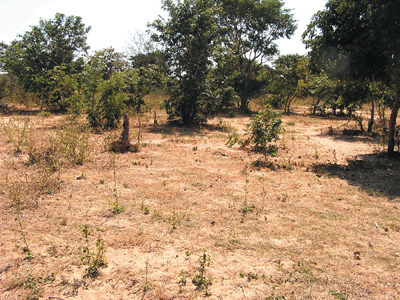 |
Typical
view of
range
condition in
the communal
land
adjoining
the ranch.
There is
little
forage for
livestock
and even
less for
wildlife.
Shrubs,
weeds and
trees have
flourished.
Most grass
is annual
and thus
already dry.
What
perennial
grass
remains is
severely
overgrazed
by
livestock.
(Photo
courtesy
Africa
Centre for
Holistic
Management)
|
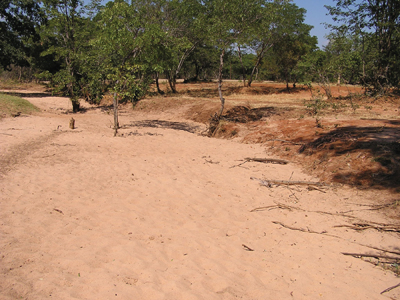 |
A river
typical of
all the
rivers
arising on
the communal
land. This
river flash
flooded a
few times in
the rains,
but
otherwise
remained
dry.
Livestock
run on this
land must
now water on
what are
known as
boreholes
with water
pumped up by
hand from
deep
underground.
There is
virtually no
water for
wildlife
through the
long dry
season.
Drought and
livestock
are blamed
for a
situation so
serious that
the bulk of
the people
are being
fed largely
by
international
aid relief
on what is
inherently
highly
productive
land.
(Photo
courtesy
Africa
Centre for
Holistic
Management)
|
 |
This
photo, taken
on the same
day as photo
2, shows the
grass
alongside
the river
arising on
the adjacent
Dimbangombe
Ranch under
the
management
of the
Africa
Centre for
Holistic
Management.
This long
grass grows
in favorable
and very
large
low-lying
areas. It is
currently
providing
significant
employment
and income
for
thatching-grass
cutters as
thatching
grass for
homes,
hotels and
safari
camps.
(Photo
courtesy
Africa
Centre for
Holistic
Management)
|
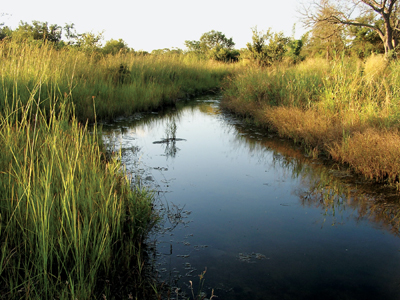 |
The Dimbangombe River rises on the ranch. This shows the water in it following two years of lower-than-average rainfall. The river now supports water lilies, reed banks, fish of several kinds, pythons, otters, water turtles, kingfishers, a great many species of birds including one pair of fish eagles, and small mammals and reptiles. It also provides year-round water for a great many elephant, buffalo, sable antelope, waterbuck, kudu, reedbuck, zebra, giraffe, lion, leopard, hyena, wild dog, cheetah, warthog, bushpig and other game that have begun to increase.
At the outset, this stretch of the river had provided water in one or two pools only in good seasons but dried up in most seasons. The river is not yet flowing again perennially (as almost all rivers in the area once were), but it has this year flowed until one month before the next expected rains and has had perennial pools along its full length throughout. So the wildlife, including the fish and all life supported by them, are now able to exist throughout the year without dying off.
(Photo courtesy Africa Centre for Holistic Management)
|
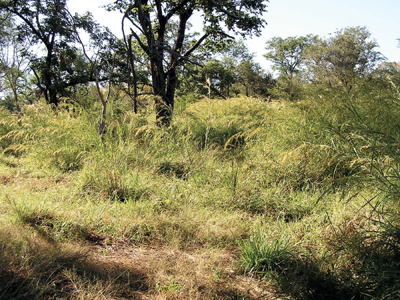 |
Another view of the land shows average grass coverage, more typical of grass on the ranch than the very long grass shown in photo 3, which tends to occur in certain areas. All of this land improvement was done using a large mixed herd of mainly cattle and goats, but with a few sheep, donkeys, pigs and horses, and one tame elephant joining the herd some days. (We plan to add more elephants to the herd in future.) No range management action was taken other than to increase animal numbers significantly and use holistic planned grazing (as opposed to rotational or management intensive grazing).
In this case, we use one herd and no fencing. The herd is held overnight in a moveable ălion-proofä kraal (livestock pen), and leaves at dawn to graze according to the plan. After the allotted time in one area of the ranch, the herd, together with the lion-proof kraal, is moved to another area. This procedure is necessary, as we have no desire to kill predators so essential to healthy wildlife and plant communities. Some readers may be aware of the reduction in vegetative damage along riparian areas of Yellowstone National Park since the reintroduction of wolves. As I have often expressed, predators are necessary to change the behavior of their prey and its relationship to the soil and vegetation, or we have to handle the livestock in a manner mimicking that of old under-predation threat.
Most of the cattle were obtained by offering cattle owners on the communal land grazing and care of their animals to save them from the perennial ădroughtä and almost certain death they were suffering under the same rainfall. Some of these cattle owners recently stated to Roland Bunch, who had been engaged to independently investigate, that had they not been able to send their animals to the ranch, they would have none left today.
(Photo courtesy Africa Centre for Holistic Management)
|
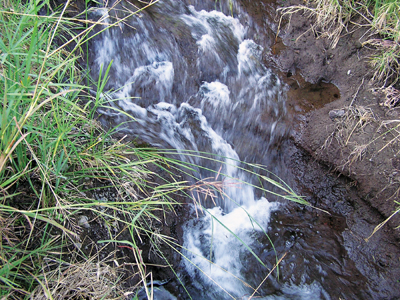 |
Water running in the Dimbangombe River on the ranch. It only stopped actively running in October, one month before the new rains.
(Photo courtesy Africa Centre for Holistic Management)
|
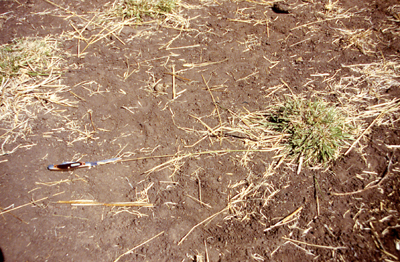 |
This photo was taken on the Dimbangombe Ranch in July 1989÷about midway through the long dry season÷before Holistic Management was introduced. The ranch supported only a few cattle and was in a terrible state, especially along the river. Setaria grass (bristle grass) is shown severely overgrazed and putting out a seed-bearing stalk along the ground, below grazing height. The bare soil led to the Dimbangombe River going dry most years, as rivers still do in the communal lands.
(Photo courtesy Africa Centre for Holistic Management)
|
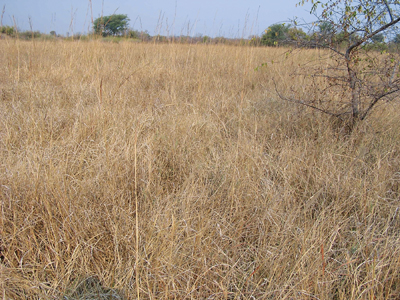 |
This picture was taken in as near as could be ascertained the same spot as photo 7. It shows the same Setaria grass growing as it normally should. Bare ground is largely a thing of the past; hence the river is flowing once more.
(Photo courtesy Africa Centre for Holistic Management)
|
Spring
2005
Contents
|

